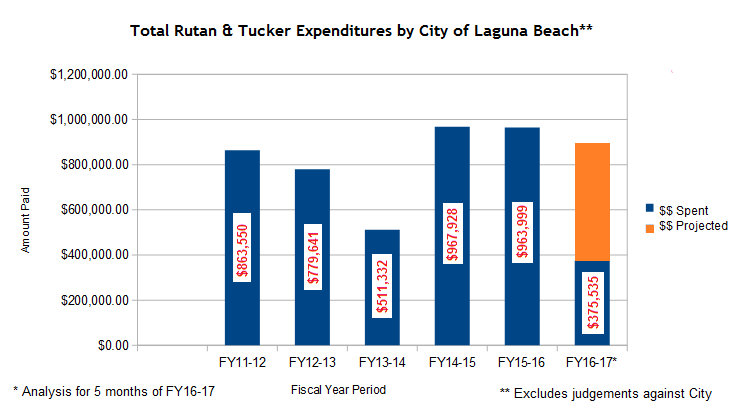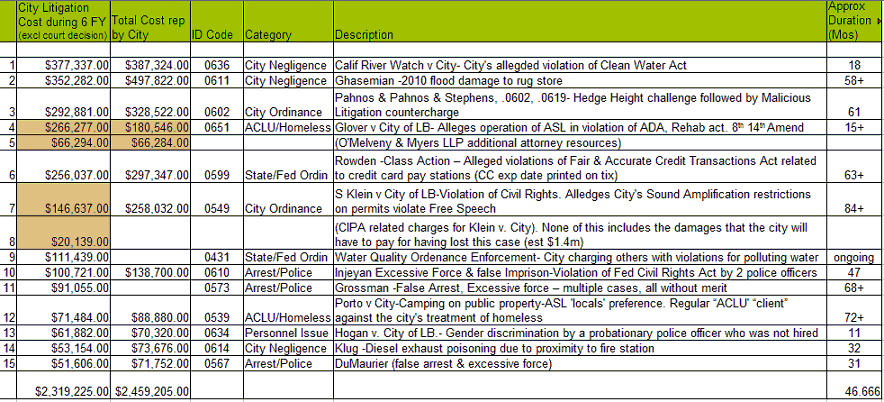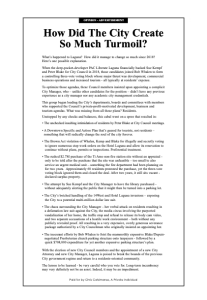Laguna Beach Legal Spending Update 2019-2020 – Click here
Update on Rutan & Tucker LLP costs to Laguna Beach City Tax payers in city funded lawsuits through 2018. Click here
This past March Laguna Beach witnessed its 38th anniversary of its relationship with the Rutan & Tucker LLP (R&T) law firm. 38 years is an extraordinarily long run for any 3rd party vendor servicing a public entity customer, especially so in the case of a City Attorney (CA). Should we assume that the reason for the longevity of this relationship is the stellar representation that the residents of Laguna Beach have received from R&T or might there be other factors behind this remarkable run?
Regular readers of this website will recall that LagunabeachCHAT did an analysis of all R&T invoicing to the City for fiscal years 2010 through 2016 (see http://lagunabeachchat.com/well-see-you-in-court/) to get a sense of the actual costs to taxpayers that legal representation has cost residents. The earlier analysis gave us a sense of the costs, but did not address the question of whether the legal representation that was involved in these cases was indeed in the best interests of the taxpayers. We hope to gain insight into the legal representation that R&T have been providing to the City in this article.
Firstly, to be clear, the author is not an attorney and has no legal training. Therefore this analysis is not founded upon a legal review of the cases or laws related to them. Instead, this review is founded upon an analysis of “reasonableness” and a common-man understanding of legal principles in the U.S. By this we mean that if the City found itself the defendant in a lawsuit resulting from an ordinance it passed that was in clear violation of accepted legal principles, then we would question:
a) why the City’s legal council did not persuade the City Council to avoid passing such an ordinance in the 1st place
b) why the City’s legal council did not persuade the City Council to settle such a case and void the offending ordinance before litigating the issue before the courts
We will also look at the City’s most costly and long-running litigation/cases and try to understand why the City’s legal council might not encourage the City to arbitrate such cases to closure rather than endlessly fighting before the courts. (Note: the term “cases” includes all claims filed with the City as well as issues that have resulted in litigation before the courts).
Background
As stated earlier, the City has used the R&T law firm as its outsourced legal representative since March 1979. Currently, Mr. Philip D. Kohn acts in the role of “City Attorney” and has done so since at least 2002. Other R&T employees who act as “Assistant City Attorney” on behalf of the City are:
- Noam Duzman
- Hans Van Ligten
- Ajit Thind
Interested readers can look on the LagunabeachCHAT website to see the Form700 filings (statements of Economic Interest) for 2016 for all four of these individuals. R&T are a California based firm with 140 attorneys and have wide-ranging practices, including government law. They currently or formerly act(ed) as City Attorney for San Juan Capistrano, City of Irvine, San Clemente and Dana Point in addition to Laguna Beach.
The current contract with R&T stipulates a monthly retainer of $8,500.00 for up to 60 hours of attorney time. Additional attorney time beyond the monthly 60 hours is billed at $235.00 /hr, which is a fairly standard rate under such arrangements. For Paralegal services the City is billed at the rate of $125.00/hr and for Document clerk services, $50.00/hr.
Our earlier analysis of the 2010-2016 billing records showed that the City’s legal expenses (ignoring any judgements against or for the City) have been trending upwards towards $1million annually, with our projected legal expenditures for FY16/17 nearing $900,000. And in what has become a standard operating procedure due to these ever-increasing costs, the City Council has again had to earmark additional funds at its mid-year budget review for legal services (i.e., an additional $500,000 set aside on 2/07/17 against the original budgeted amount for FY 16/17 of $635,000). This pattern is identical to the pattern followed in previous years which makes our City’s actual costs for legal services quite opaque to all but the most attentive observers. Figure 1 is a graphic from the earlier article that shows the expenditures for the period analyzed:

Figure 1
These expense amounts include the monthly retainers, ongoing legal advice and representation, and of course the costs for litigation. Litigation includes both cases where the City is the plaintiff, but more commonly, where the City is the defendant. Table 1 shows the 15 most expensive litigation suits/legal cases that the City has been involved in during the analysis period (the costs listed do NOT include any judgements that the City will be required to pay-out, if it loses):

Table 1
LagunabeachCHAT holds the opinion that Case 3 stemmed from a foundation of a poorly written ordinance with poor procedure built around it. Reading the volumes of transcripts from the related cases comprising Case 3, one is struck at the flimsy basis of the ordinance itself and the unsophisticated and ad hoc nature the processes built around it. Laws of this type are magnets for dispute and ongoing litigation. It is also notable that Council passed this CA reviewd hedge height ordinance as though Laguna Beach has a Charter and did not have to follow state code (of course the City is a General Law city which means it must follow the State’s lead).
Likewise it would seem that even a 1st year law student could see the potential 1st amendment problems with the “amplified sound” ordinance at the center of case 7. How the City Council was allowed by the CA to put this ordinance into effect is inconceivable. One has to wonder whether prior to implementation, any effort was made to review case law to see whether similar ordinances elsewhere had met with lengthy or costly lawsuits. Given that the plaintiffs in the case were lawyers themselves, a prudent reading of the circumstances would have urged caution once the lawsuit was filed. Its very likely that plaintiff attorneys were looking for headlining 1st amendment case and our hayseed City Council provided them one based on the ill-advised amplified sound ordinance.
We also fear that poor legal advice lies at the heart of the cases in Table 1 categorized as: ACLU/Homeless (cases 4 and 12). The core legal issue behind these ACLU lawsuits is the City’s enactment of various vagrancy laws making it illegal to camp or sleep in public areas. No doubt such ordinance(s) were (and still are) very popular as an attempt to stem the increasing numbers of homeless blighting our public spaces. The problem is that the core elements of typical vagrancy laws have repeatedly been found to violate numerous federal laws, not to mention the 8th and 14th amendments to the U.S. Constitution. In the City’s attempts to ward off earlier ACLU lawsuits against the original vagrancy law, the City compounded the problems in its unilateral attempts to ‘fix’ the issues. Homelessness is a far too big and complex problem for any city to tackle on its own, and the City was ill advised to attempt it to the exclusion of broader countywide and statewide efforts. So now the City finds itself constantly defending itself against incremental ACLU lawsuits which are demanding that ever more services and resources be devoted to the homeless, with no end in sight.
Regardless of the case, we also wonder what ‘stop-loss’ guidelines are in place to ensure that lawsuits are not being fought once defeat is likely. A prime example is Case 7, the 1st amendment case. Would it not be in the best interests of the defendant, to have the CA advise the likelihood of winning vs. losing, and with that analysis to decide that its in the best interest of taxpayers to throw in the towel? This analysis should certainly be done once a claim is made against the City, but it should be repeatedly done as the claim progresses into a lawsuit and as it churns its way through the legal system. Seven years is far to long a time horizon to allow a losing lawsuit to be faught. Of course an outsourced City Attorney is racking-up enormous extra billing as a result of the continued fight on such “lost cause” cases.
The Role of City Attorney
This author believes that the top responsibilities of a City Attorney includes the following:
- Ensure constitutional (and property) rights of the residents, city employees and vistors are upheld in all City ordinances
- Minimize litigation where the City is the defendant
- Provide ongoing legal advice and representation to the City
An independent, elected CA would focus on these priorities in roughly this order because the electorate would punish him or her for failing to do so. We can not be sure whether an outsourced CA would do the same. Unlike an elected CA who is beholden to the electorate, an outsourced CA is working for City Hall and thus, the City Council. The two constituencies are not necessarily aligned. Recall, an outsourced CA is paid for any work that exceeds their monthly retainer. Ongoing litigation is potential money spigot for the CA’s law firm, so there is an upside to not stopping their customer from enacting legally questionable ordinances and encouraging their customer to defend weak cases.
Consider a hypothetical situation where the City Council wants to enact a popular ordinance. Perhaps the proposed ordinance is politically popular and will help council members in their re-election bids. The legal foundation of the proposed law is shaky; indeed other jurisdictions have found themselves being sued because of a similar measure. What might we expect under an elected CA vs. outsourced CA situation?
Elected CA –
- The elected CA would be expected to advise the council about the legal downsides of enacting the proposed law.
- They would go on the record, stating their misgivings of proceeding with the ordinance
- When the inevitable lawsuit(s) are filed by plaintiffs regarding the ordinance, the CA may decide NOT TO DEFEND the suit, instead working to settle.
Outsourced CA –
- The outsourced CA would be expected to advise the council about the legal downsides of enacting the proposed law.
- If the council persists, the outsourced CA (who maintains their position at the pleasure of the council) drafts the proposed ordinance which the council will pass into law.
- When the inevitable lawsuit(s) are filed by plaintiffs regarding the ordinance, the outsourced CA will follow the council’s demand to defend against the suit.
I believe that Laguna Beach has seen many examples of the latter hypothetical scenario play out (e.g. Klein v. City). Are there any instances where the City has decided to not defend a lawsuit that is based on ordinances it has passed? Given the dynamics of an outsourced CA who serves at the pleasure of City Hall who also stands to benefit financially from litigation, it is extremely unlikely and indeed LagunabeachCHAT is unaware of any such cases.
Conclusion
Our review of the legal expenditures and litigation cases for the past 6 fiscal years caused us concern about Laguna’s having an outsourced CA. The lack of accountability to voting taxpayers together with the misaligned financial incentives inherent in having a private law firm representing the City lead us to conclude that the City would be better served by having an elected City Attorney, or at a minimum, that the City should go out to bid for other possible law firms to represent our legal interests.
The current CA’s modus operandi seems to be to deliver any and all new ordinances that the City Council dreams up with minimal attempts to convince their customer to reign-in laws that might overreach or attract lawsuits. Given that, what legal jeopardy might the City be inviting with its leading-edge ordinances on:
- City-wide smoking ban
- Drone regulation
- Short Term Lodging prohibitions
- View restoration
Time will tell but we don’t expect to see the legal expenditures trend-line seen in Figure 1 decreasing anytime soon as long as our CA reports to the City Council/City Manager and is not held accountable for the City’s legal expenditures.



